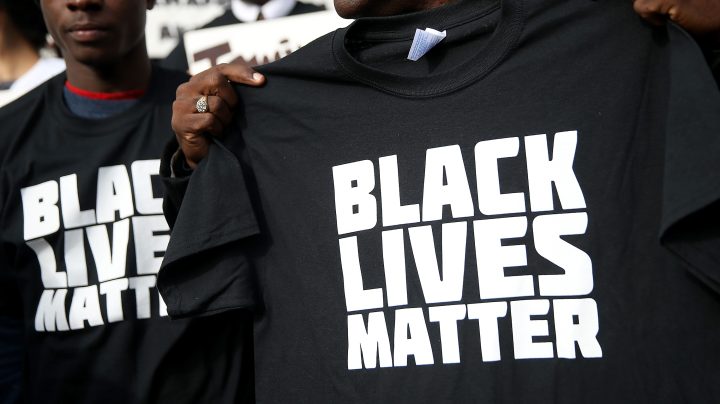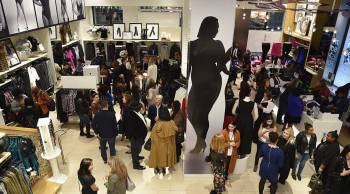
How clothing can be a ‘tool of resistance’
How clothing can be a ‘tool of resistance’

What you wear says something about what you mean. Because of that, clothing and style can play important roles in social movements. Tanisha C. Ford is a professor of history at the City University of New York who studies social movements. She talked with Marketplace host Kai Ryssdal about the influence clothing has had on movements of the past and of today. The following is an edited transcript of their conversation.

Kai Ryssdal: Do me a favor, would you, and give me some examples from history of fashion and protest movements and how they’ve kind of aligned.
Tanisha Ford: A few highlights to me, and thinking of clothing as a tool of resistance, I think of the suffragettes and their sashes and their use of white dresses, the Black Panther Party and their wearing the black leather jacket and black berets. I think of Act Up and their “Silence equals death” T-shirts. And also more recent examples include the hoodies and “Assata taught me” T-shirts that Black Lives Matter activists have worn, and even those very bright and iconic pink pussy hats of the Women’s March.
From left to right: A suffragette parade in 1911 (Topical Press Agency/Getty Images); members of the Black Panther Party in 1969 (Jean-Pierre Laffont/Michael Ochs Archives/Getty Images); an activist wearing a pink pussy hat in 2018 (Adam Berry/Getty Images).
Ryssdal: I said “fashion” and you said “clothing.” Is there a difference in your mind as it comes to protest movements?
Ford: To me there is a difference because I think that most often, activists, when they think about a symbol for their collective politics, they think of something that’s already a part of the everyday wardrobe of that group. For example, if we use that hoodies example, again, those hoodies were things that were part of the hip-hop culture and hip-hop ethos of style. And so when activists are wearing them, they’re not necessarily wearing them as a fashion statement. They’re wearing them as a symbol that represents very organically the group of people who are mobilizing against something like police brutality. So what happens oftentimes, though, is that corporations, fashion brands, they take those things and then elevate them to fashion, if you will. So they make it so that the everyday person wants to buy a hoodie, you know, a black hoodie with white writing or lettering on it.
Ryssdal: I was struck by the adaptability and utility of clothing in a protest movement and specifically, back in the civil rights movement where the order of the day clothing-wise, early on, was suits and ties — look prim and proper and present yourself well — and then later change to as the activists and the movement became younger, change to overalls and T-shirts. Talk about that for a minute, would you?

Ford: You know, that was one of my greatest finds when I was working on my first book, “Liberated Threads.” I started to look around and see some of the digital archives from the civil rights movement, and one of the things I noticed was that there were these young activists who were part of this Student Nonviolent Coordinating Committee, or SNCC, and they were wearing denim overalls. And what I learned after interviewing several of those people, and also reading the FBI files on some of those prominent activists, was that they were wearing those overalls to align themselves with the Southern sharecroppers they were organizing alongside of in places like rural Mississippi and rural Alabama. So they were wearing those things to reject the respectability politics of the national NAACP, which, of course, as you mentioned, you know, kind of becomes representative of this upstanding “Sunday’s best” attire. But they were using those things to say, OK, as young college folks, we want to have a particular kind of class consciousness as part and parcel to our political platform, and the denim overalls became part of that.
Ryssdal: Hmm. All right, so let me throw a history professor question at the history professor. Compare and contrast that with what we see today, where everybody’s out there, there’s no uniform, and yet there is some uniformity.

Ford: Right. You know, I think that the Ferguson moment was really powerful in that those activists kind of set an attire that activists today in 2020 are still wearing. I can think of people like Tef Poe, saying, listen, we’re not gonna be ashamed of our tattoos, of our, you know, our ball caps, of our T-shirts, that this is part of it for us. So what we see now, with protesters on the street today, you still see those message T-shirts, box braids in colors that are bright red and vibrant orange — I mean, all of that is a part of it, and I really love to see it. It also speaks to the queerness of this movement, that you know, these movements were sparked by not only young Black people, but young Black queer people. And so we see a queer style aesthetic become central to Black Lives Matter organizing in ways that we hadn’t seen in the previous generation. Especially not in ways that made it into the more mainstream archiving of those movements.
Ryssdal: Imagine yourself a history professor, which you certainly will still be 25 years from now, one hopes, as you look back on this moment, what’s gonna stand out to you?

Ford: You know, for me, it’s these masks. It’s the COVID-19 masks. You know, people are wearing masks to protect from infection. So the masks then become a different kind of armor, right? So on the one hand, we want to get across a message to the police: “Stop killing us.” But in order to take that kind of collective stand, we have to go out and be on the front lines of a protest in the midst of a global pandemic. And that, to me, is representative of what it’s like to be Black in this country — to always be choosing from a set of possibilities that are unfavorable. I encourage people, though, to exercise their right to protest, but gosh, I just really hate to see us have to do it under these conditions in which we know this virus is so infectious and so contagious.
There’s a lot happening in the world. Through it all, Marketplace is here for you.
You rely on Marketplace to break down the world’s events and tell you how it affects you in a fact-based, approachable way. We rely on your financial support to keep making that possible.
Your donation today powers the independent journalism that you rely on. For just $5/month, you can help sustain Marketplace so we can keep reporting on the things that matter to you.





















